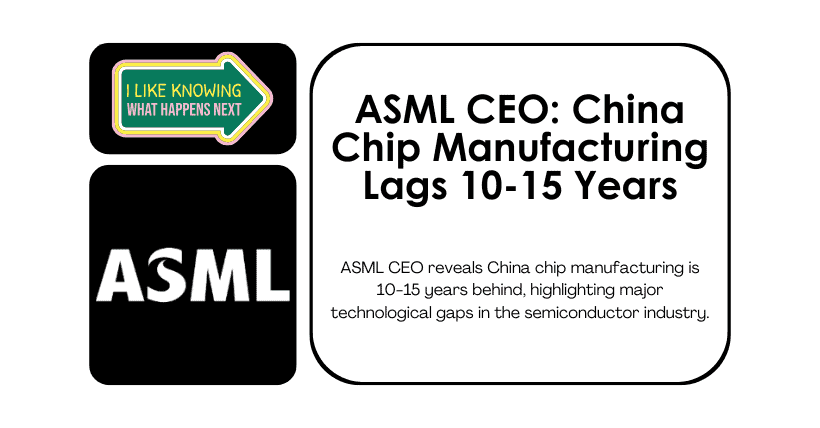Fouquet pointed out that due to the EUV lithography machine export ban to China, China’s chip manufacturing technology is still 10-15 years behind the West.
Christophe Fouquet, CEO of Dutch chip tool manufacturing giant ASML, stated that despite the considerable progress made by SMIC and Huawei in the semiconductor field in recent years, these two companies are still 10 to 15 years behind industry giants like Intel, TSMC, and Samsung. It is well known that even with top-tier DUV equipment, China’s wafer fabs, such as SMIC, cannot match TSMC’s process technology in an economically efficient manner. This is because Chinese companies cannot access leading EUV lithography equipment.
“By banning the export of EUV, China will be 10 to 15 years behind the West,” said Christophe Fouquet in an interview with NRC. “It really makes a difference.”
Under the Wassenaar Arrangement, ASML has never shipped its EUV equipment to China. However, ASML has continued to release advanced DUV lithography tools, such as the Twinscan NXT:2000i, which can produce chips with 5nm and 7nm process technology. This has undoubtedly helped Chinese tech giants endure U.S. government sanctions.
After realizing that EUV equipment would not enter China, China began exploring extreme ultraviolet lithography technology on its own, aiming to build its own lithography chip manufacturing and ecosystem, which will take at least 10 to 15 years. For reference, ASML and its partners took more than 20 years from initial research to commercial machines and the development of the EUV ecosystem. Many of the technologies developed in the early-to-mid 1990s are publicly available, so Chinese companies do not have to start from scratch. However, when China’s semiconductor industry develops low numerical aperture EUV tools, the Western chip industry will already have high numerical aperture EUV lithography and even Hyper-NA EUV devices.
The main concern is not that Chinese companies might develop their own EUV lithography machines in about 15 years, but rather that they could replicate ASML’s mainstream DUV equipment (such as the Twinscan NXT:2000i) in the coming years.
The U.S. government is pressuring ASML to stop maintaining and servicing its advanced DUV systems in China, which would align with existing sanctions against the Chinese semiconductor industry. However, the Dutch government has yet to agree to this request. ASML aims to retain control over its machines in China to prevent sensitive information leakage risks, which could arise if Chinese companies take over maintenance to keep their chip fabs operational.
Currently, Chinese companies are among ASML’s major customers, with ASML earning billions of dollars by selling DUV lithography tools to SMIC, Huahong, and Yangtze Memory Technologies. It remains unclear what will happen if Chinese lithography equipment manufacturers build their own DUV lithography systems (or simply copy the systems developed by ASML). On one hand, they could reduce purchases from ASML, but on the other hand, they could start selling these tools outside of China, essentially competing with ASML. While it’s unlikely they will produce machines like the Twinscan NXT:2000i in the short term, replicating less advanced machines could be much easier.
Fouquet’s statement is his first public comment on the semiconductor development gap between China and the U.S. since he became CEO in April 2024. He emphasized that the global market urgently needs mature chips made in China to fill the supply-demand gap, especially in Europe. However, in the field of lithography machines, China still cannot produce advanced equipment independently.
ASML plays an irreplaceable role in the global semiconductor supply chain, with nearly 90% of chip production relying on its lithography systems. DUV lithography machines can meet the needs of chip manufacturing at 7nm and above, while the advanced nature of EUV lithography machines makes them the core equipment for 5nm and below process nodes, and ASML is the only global supplier of EUV equipment.
This year, ASML’s High NA EUV lithography machine has become a new “top-tier” device. Its numerical aperture (NA) has been increased from the standard EUV machine’s 0.33 to 0.55, with the resolution of the lens improved from 13 nm to 8 nm, enabling mass production of advanced processes below 2nm. Companies like Intel, TSMC, and Samsung are willing to spend enormous sums to secure this technology.
It is worth noting that despite these challenges, China’s semiconductor industry continues to grow rapidly. In the first ten months of this year, China’s semiconductor exports exceeded 931.17 billion yuan, a 21.4% increase compared to the same period last year. The Chinese Ministry of Foreign Affairs has also voiced opposition to the U.S. export control policy, emphasizing that such actions undermine international trade order.
Overall, the competition in the tech industry is extremely fierce. As ASML faces pressure, it continues to work tirelessly to ensure stability in the global market. As Fouquet mentioned, the competition among giants is not only about the survival of businesses but also has a significant impact on the future development of global technology.
Source: Internet
Related:
- Is the Move to 5nm Chip Technology Part of a Conspiracy?
- How ASML Builds Its Billion-Dollar Lithography Machines?

Disclaimer:
- This channel does not make any representations or warranties regarding the availability, accuracy, timeliness, effectiveness, or completeness of any information posted. It hereby disclaims any liability or consequences arising from the use of the information.
- This channel is non-commercial and non-profit. The re-posted content does not signify endorsement of its views or responsibility for its authenticity. It does not intend to constitute any other guidance. This channel is not liable for any inaccuracies or errors in the re-posted or published information, directly or indirectly.
- Some data, materials, text, images, etc., used in this channel are sourced from the internet, and all reposts are duly credited to their sources. If you discover any work that infringes on your intellectual property rights or personal legal interests, please contact us, and we will promptly modify or remove it.



